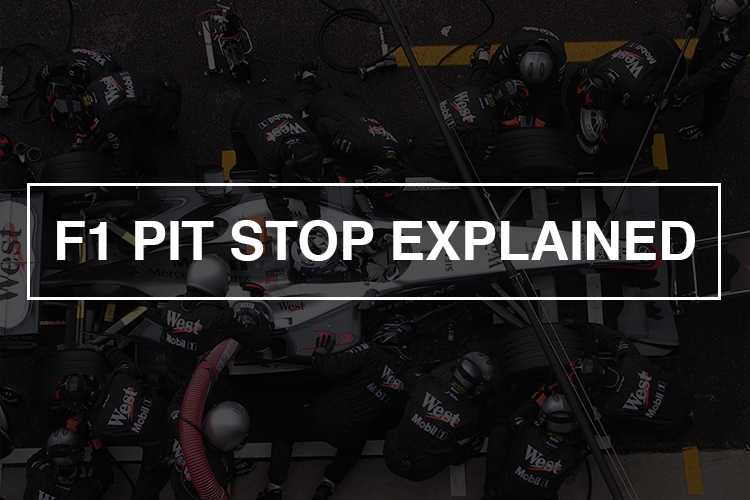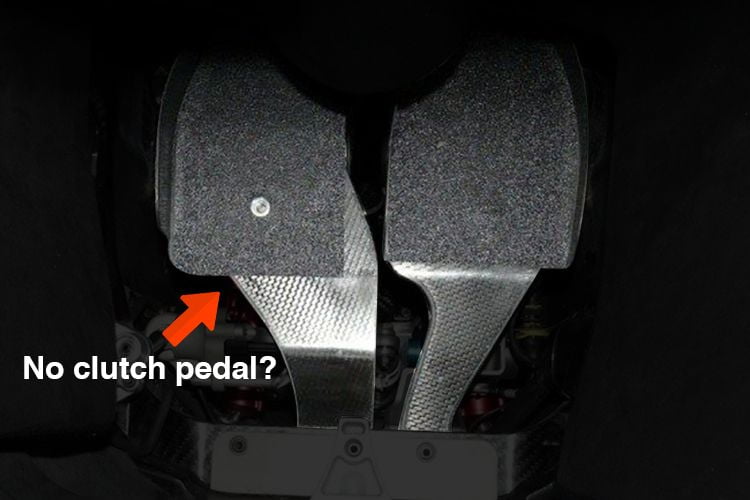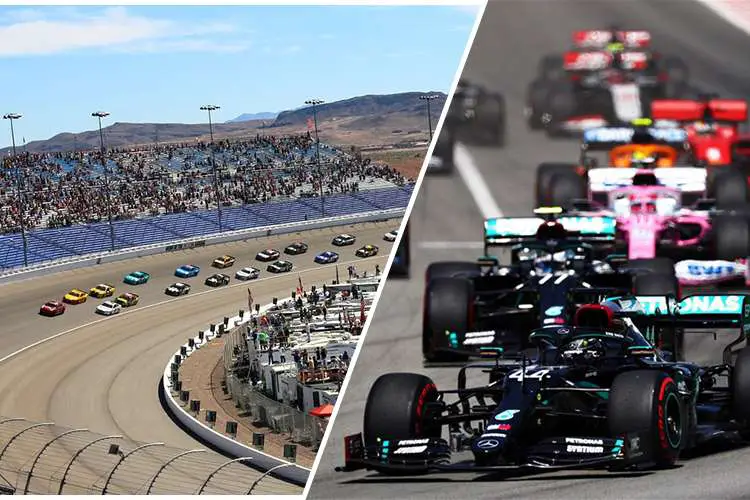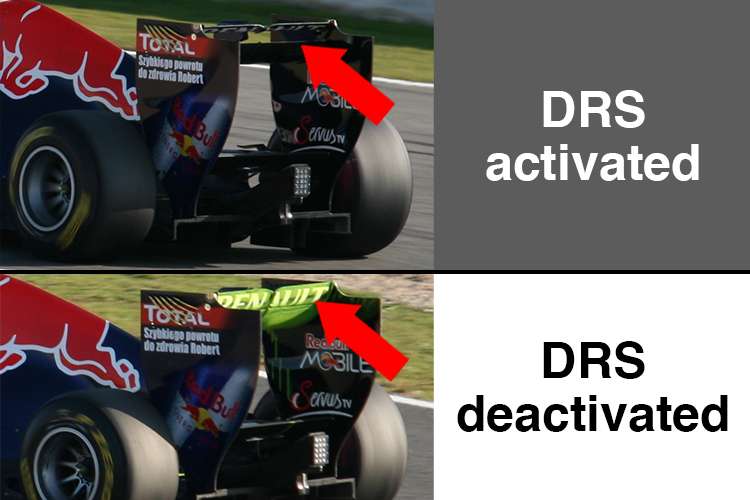Last Updated on September 23, 2023 by Pittalks
Formula 1 fan were treated to a new rule in the sport in 2011 with the introduction of DRS (drag reduction system). But what is DRS, and how does it work?
The rule allows drivers to open their rear wings in designated zones on the track to reduce drag and increase speed.
In this blog post, we will take a closer look at DRS in Formula 1 and discuss some of the pros and cons of the new rule. We will also highlight some of the best DRS overtakes in history.
So, without further ado, let’s get started!
What is DRS in F1 and how does it work?
DRS stands for Drag Reduction System. It allows the chasing car to close up the distance on the leading car. During a DRS activation zone (a straight), the driver can push a button on his steering wheel to open the rear wing. When it does, the car has less drag and gains more speed.
The difference in speed over the 750-meter distance is between 10–12 km/h. The idea behind the DRS is to allow for more overtaking in F1 races.
Understand why DRS makes overtaking easier
Modern F1 cars gain their immense speed in two ways of grip:
- Mechanical grip is generally constant and is derived from the tires and suspension setups
- Aerodynamic grip – cars use the wind that sails over, pushing them down.
Manipulations of the air around the car’s body allow the air to push the car down beyond its weight and create an additional force that generates more grip through the corners. This is called downforce. The higher the speed, the more air flows over the car, and the greater the downforce.
Sadly, downforce is not free, and it has a price to pay. In comes drag, the byproduct of downforce!
Downforce is the vertical portion of a two-dimensional force. The horizontal one is the drag! It acts against the car’s motion, exactly like a parachute would. The more downforce you require from the aerodynamic parts, the more drag they will have, slowing the car down on straights.
It is always a compromise between straight-line and cornering speed, which is highly dependent on the track!
The premise of DRS originates from the nature of the modern F1 car. With its massive reliance on aerodynamic grip, chasing cars are held back by a phenomenon known as dirty air.
Naturally, when the aerodynamics of the racecars are designed, they are designed with a clear and stable stream of air in mind. With an average speed of 161 mph (260 km/h), F1 cars leave a strong wake behind them. It’s exactly like when a truck passes by you (but ten times stronger than that.)
This wake of disturbed and turbulent air is severely destructive to the vehicle’s aerodynamic performance, sharply decreasing its speed.
As a result, you see drivers only just being able to follow each other, but from a very far distance, where the dirty air has stabilized again. Because of dirty air, without DRS, overtaking by the speed in F1 is not an easy task!
On the straights, DRS offers the drivers the ability to sacrifice their unneeded downforce for the sake of speed. To achieve that, the rear wing is rotated to a horizontal position. This decreases the downforce generated, and as a result, it reduces drag. Consequently, the car’s straight-line speed increases significantly, bringing the leading car within striking distance of the chasing one.
content continues below
DRS rules
DRS is not a “use it when you want it system.” It’s regulated to certain parts of the track, mainly the start-finish straight, and the back straight.
If the two cars are not within one second of each other, the chasing car will not be allowed to activate the DRS system. In addition, the leading car is not allowed to use its DRS at all.
In addition, the DRS can’t be used in dangerous racing conditions (such as rain.)
The debate over DRS
DRS has caused a stir in the F1 community since its debut in 2011. Many claims that it just made passing like a drive-by, while others consider it as a saving grace in the days of aerodynamically driven cars!
The Race did a poll regarding whether F1 should get rid of DRS or not. And the results are in favor of the DRS, with only 12% voting to remove DRS and 43% voting to keep it.
45% of fans wanted to wait until the 2022 season offers a more comprehensive view.
With that in mind, let’s see what are the two aspect of the DRS.
DRS makes F1 more interesting
The DRS allows chasing cars to get closer their opponents and keep the rest of the overtake up to the driver. It simply brought them to a position where they could fight and not hang back, hoping they were closer.
As mentioned above, only cars behind get the right to use the DRS! This has led to exciting battles of strategy. Drivers were not only fighting for track positions but also for the methods to get that track position.
They will fight for that DRS just like they would fight for their racing line. How can they do that?
The answer is giving up their track position by not defending fiercely or even letting off the gas early. Before entering the DRS zones, the leading car gives the chasing one a fake advantage and allows it to pass, which he can gain back during the DRS and keep his original position.
Sometimes, the fight for the DRS gets a little too exciting. When two rivals are going head to head, close on points where the race will decide who will lead the championship. That’s where the weird (and controversial) things happen.
Last year in Jeddah, Max Verstappen was instructed to give back his position to his rival, Lewis Hamilton. Strategically, he did so before the DRS zone! Sadly though, miscommunications on the Mercedes team left Hamilton surprised to the point he rear-ended Verstappen. This year as well, again in Jeddah, Verstappen and Leclerc had a questionable incident that thankfully did not have any physical contact between the cars. Both drivers were heading into the DRS detection zone side by side on the back straight. Due to their fierce rivalry, they both wanted the DRS zone in the closing stages of the race. So naturally, they both wanted to let the other by. Knowing this, it quickly snowballed into both of them slamming their brakes in their fight for the right to use the DRS, a show in which both drivers locked up their front wheels.
That said, the leading car is not defenseless. It has an Energy Recovery System (ERS.) It harnesses energy under braking, which is then deployed for extra power. This energy is used to counter the effects of the DRS.
DRS ruins the sport
“Now it’s like giving Picasso Photoshop.”
Juan Pablo Montoya, a former grand prix driver said during an interview on The Racer’s Edge (Source.)
Critics of the DRS are quick to point out the artificial racing it creates. That it gives the leading car no chance to fight. They argue that the chasing car has a huge advantage. There are multiple instances of a pass being merely a flyby on a straight.
As aerodynamics got more and more sophisticated, the DRS efficiency did not escape the prying eyes of world-class engineers. They enhanced its abilities and manipulated the air around the DRS to further boost its effect. Unfortunately, that aids the arguments mentioned above about creating artificial racing and overtakes. Even then, the consensus is that some level of overtaking is better than no overtaking whatsoever.
How broken is DRS?
With our views and take on the DRS controversy, we leave it up to you to observe a compilation of DRS passes. Whether you think it is excessively artificial and skill-lacking, or just the right amount to get the race more exciting, let me know in the comment section below!
Conclusion
All in all, the Drag Reduction System is a solution to a symptom of the current era of F1 cars’ design, not the cause.
The aerodynamic grip is nothing new in the world of racing, not just F1, and experiments have been made as a result. The Ferrari x-wings, the Lotus skirts that created massive downforce, and even the infamous Brabham BT46, also known as the fan car, are all examples of such.
All of those brilliant creations were banned amidst concerns that the cars are getting too fast for safety to keep up! But over time, materials and designs, both to the tracks and the cars, have reached all-time high levels of safety. It surely will be fun to open doors to even faster cars that utilize previously banned technologies.
Here is to hoping that the new 2022, ground effect focused, will deliver on its promises of closer racing. And in the very foreseeable future, rid us of artificial mechanics that cause a stir among the fan.
Related articles
-

F1 pit stops 101 | All rules simply explained
Did you know that the average F1 pit stop takes just under three seconds?
In that time, 4 tires are changed, and any necessary adjustments are made. In a sport where fractions of a second can make….Read more

Why don’t F1 cars have clutch pedal? But they do have a clutch!
Since its invention in the early 19th century, the clutch has been a key component of all motor vehicles. But do race cars like those in Formula One (F1) still need them?

NASCAR vs. F1: The Ultimate Showdown
Did you know that the first NASCAR race was held in 1949, while the first Formula One (F1) race wasn’t until 1950?
Nowadays, F1 races are typically watched by fans all over…


